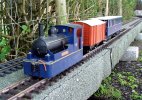Permanent no derails would be nice and something to work on.
Page 13 (minus 1).
Curb any enthusiasm you have for running anything at all, until you fix your track properly, and I mean properly. Rip up what you have laid, and build a firm formation for your trackwork. In the case of garden railways, a firm foundation is something you can walk on, and not leave any deformations behind! Then, and only then, set out your trackwork, ensuring it is to a good line, even grade, no dippy or kinky joints, and flat crosslevel (cant, is the term). Fix the track to the formation using your chosen method (screws to solid base, or ballast on formed roadway just like the real thing). Now, you are ready to do the push tests, get some rolling stock, and push it around your track, each time doing it a bit faster until you get to a speed that you plan to run at. When doing all that, put a few drops of 3 in 1 oil on the rails in a various places, your test train is going to clean your track for you. Keep doing all this until you don't get derailments. If you do get derailments, fix the track, and keep fixing it until you don't get derailments.
Now, perhaps, you just might be ready to run a loco, using whatever power source you decide on. Of course, you will have bench tested it first. Run it by itself for a while, getting a bit faster each time. Then, after not having any derailments, haul a train around. If the track is good, and the train is good, you shouldn't have any problems. Now, we are half way there.
The ultimate test for a garden railway, is to run your train flat out, in reverse ! This will not only test your trackwork, which is of course perfect, having followed all the advice you have received by now, but, will test your rolling stock..... but that subject will be for later discussion.


